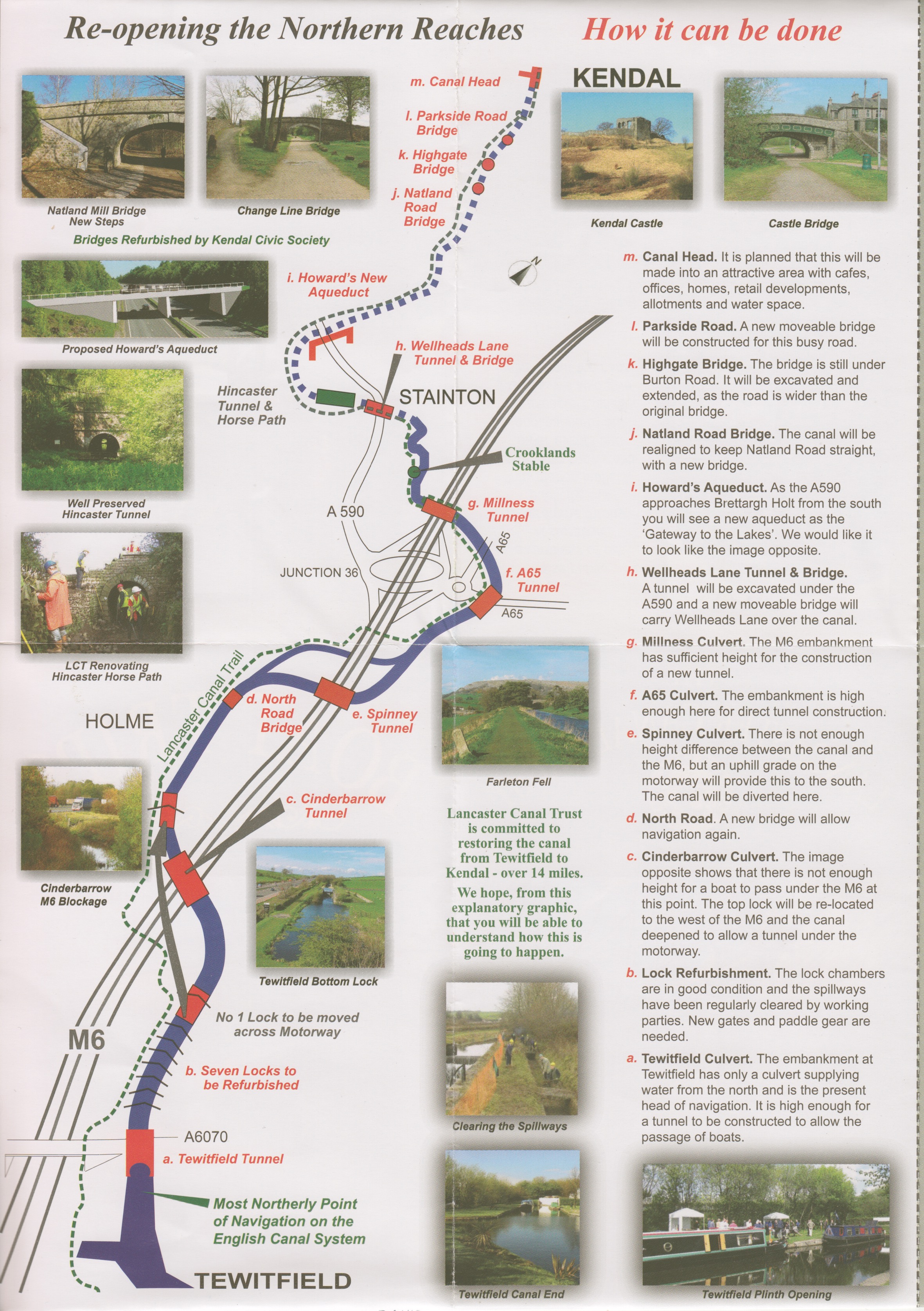
Opened 1819.
A prime example of a canal where boats were hauled through by hand whilst their horses took a purpose-built path over the hill.
Hincaster village,
South Lakeland District,
Cumbria
The first scheme for a canal linking Kendal and Lancaster with Manchester (to take coal from the Wigan and Worsley coalfields north and limestone from Cumbria south) was put forward in the 1760’s but it wasn’t until 1792 that a route was finally agreed upon. The renowned engineer John Rennie was appointed to oversee its construction and the North End of the canal between Preston and Tewitfield was opened in 1797. Work to extend the canal from Tewitfield to Kendal began in 1813 under engineer Thomas Fletcher and it was finally completed in 1819.
This final section of canal includes some magnificent engineering feats including the tunnel through Hincaster Hill bringing the canal close to the Sedgwick Gunpowder works owned by the Wakefield family of Kendal (John Wakefield was on the Canal Committee).
Work begins
Work on the tunnel started in May of 1813, with a shaft to investigate ground conditions being sunk in Hincaster Hill by contractor Mr Rowe at a cost of £294. Fletcher drew up the ‘Specification of the Mining & Masonry of the proposed Tunnel thro’ Hincaster Hill about 400 yards in length’ in October 1813 and in November the contract to construct the tunnel was let to William Williams. It appears that Williams soon suffered financial difficulties and in June the following year his contract was terminated. Construction continued under the guidance of Thomas Fletcher until John Pritchard was contracted in August 1814.
In that same month Fletcher made the unusual move of suggesting to the canal committee that bricks be used in the construction of the tunnel. Whilst bricks were already in use for similar projects further south, it was unheard of in the north of England and the committee required considerable reassurance that brick would be suitable. However, they eventually did agree and a source of clay was identified on Milnthorpe Marsh to the west of Heversham, three miles from the tunnel site.
The tunnel has limestone portals whilst within the tunnel stone was used below water level, with brick above. The combination of materials was projected to save about £7 per yard. By 1817 the brickworks had produced over two million bricks and the construction of the tunnel was noted as complete at the proprietors meeting on 3rd February 1818.
Canal opening
The canal was officially opened the 18th June 1819 – the Westmoreland Gazette wrote that the 18th June was a glorious day for Old England (it being the anniversary of the victory at Waterloo) and predicted it will be a proud day for Kendal. In its report about the opening ceremony the Gazette wrote:
THE TUNNEL. – . . . There is no path for the horses to pass under, but the boats are haled through by a rope which is fixed along on side of the Tunnel. The Corporation Barge was 7 ½ minutes in returning through it. – The construction of this subterranean passage is such, that the least sound is reverberated a thousand times and made audible from end to end – The experiment was tried by two gentlemen – a sentence, pronounced in low tone of voice by one of them, was distinctly heard by the other, at the distance of 378 yards.
Commercial traffic on the Lancaster Canal ceased north of Lancaster in 1944 and the canal was officially closed following the Transport Act, 1955. Today it is in the care of the Canal & River Trust. The tunnel portals are listed (Grade II) and the path, constructed to take towing horses over the hill, is a scheduled monument.
Over the last few months the Lancaster Canal Trust, in conjunction with the Canal & River Trust, have been working to control the surrounding vegetation and rebuild some dry-stone walls in the area. Lancaster Canal Trust have regular work parties here and up and down the northern reaches of the canal. If you would like to get involved visit their website at Lancaster Canal Trust.
Their ambitious plan to re-open the Northern Reaches is explained below.

Bill Froggatt Heritage Advisor (North West Waterways)
Barritt, S., The Old Tramroad - Walton Summit to Preston Basin, Carnegie Publishing, ISBN-10: 01859360580 (2000)
Philpotts, R. Building the Lancaster Canal, Blackwater Books, ISBN-10: 0946623007 (1983)
Rigby, J. The Lancaster Canal in focus, Blackpool : Landy, ISBN-10: 9781872895727 (2007)
Ruddock, Ted, Arch Bridges And Their Builders 1735-1835, Cambridge University Press, ISBN-10: 0521090210 (2008)
Laws, J. & Lancaster Canal Trust, The Complete Guide To The Lancaster Canal, Lancaster Canal Trust, ISBN 978-0-9514146-6-8 (2022)
Satchell, J. Kendal's Canal : History, Industry and People, Kendal Civic Society, ISBN-10: 0950986917 (2001)
Swain, Robert, A Walker's Guide to the Lancaster Canal, Cicerone Press, ISBN-10: 1852840552 (1989)
Tomlinson, Victor I. The Manchester Bolton & Bury Canal, The Manchester Bolton & Bury Canal Society (1991)
Willis, K.G., Garrod, G. and Dobbs, I. The Value Of Canals As A Public Good: The Case Of The Montgomery & Lancaster Canals, Countryside Change Working Paper, University of Newcastle upon Tyne (1990)
The Red Wheel heritage plaque unveiling party is shown below (from left to right):
Richard Parry, Chief Executive, Canal & River Trust
Rob Shorland-Ball, Vice Chairman, Transport Trust
William Froggatt, Heritage Advisor, Canal & River Trust
Cllr. Dyan Jones, Portfolio for Localism and Climate Resilience, South Lakeland District Council
Peter Stone, Trustee, Transport Trust
